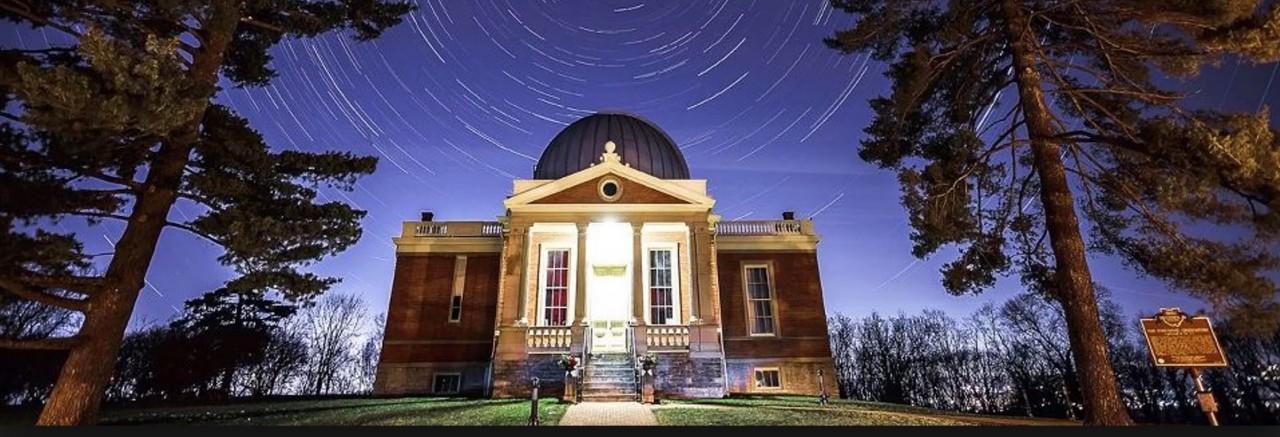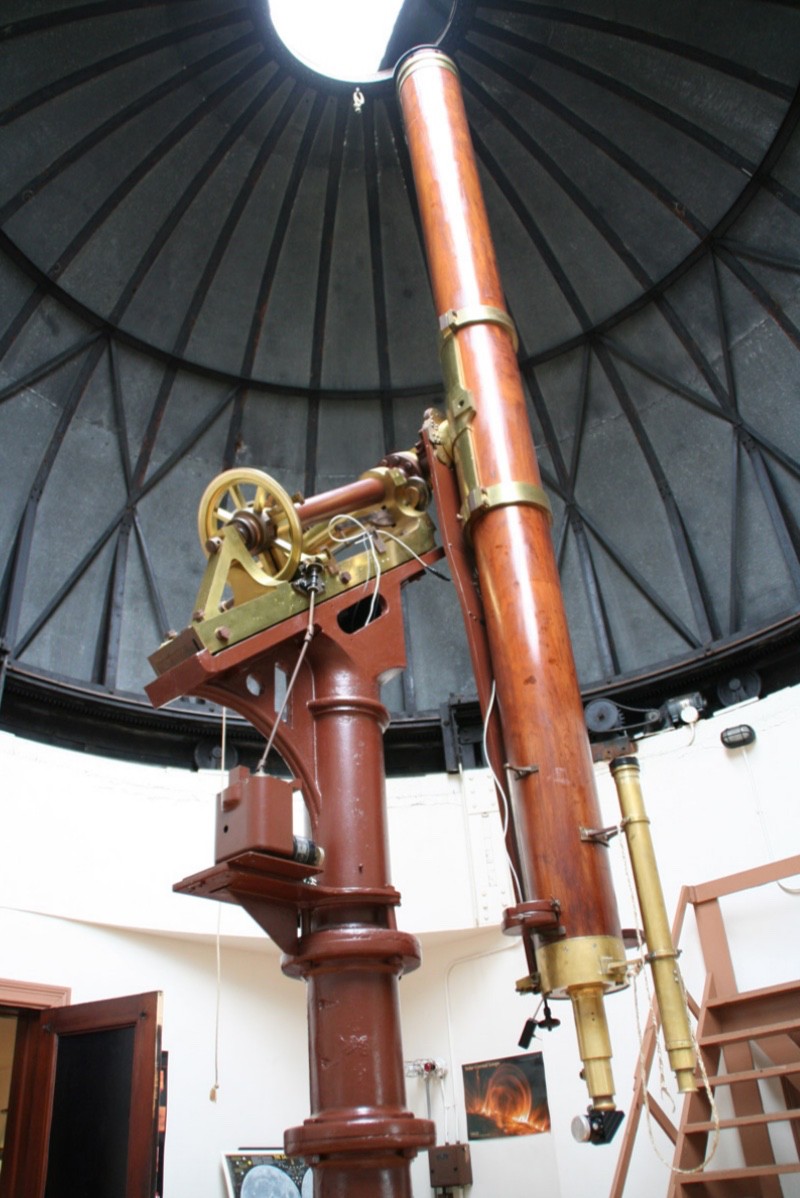
UC’s eye to the sky turns 175
The Cincinnati Observatory celebrates its rich history, connection to the University of Cincinnati and its broad astronomical impact at its 175th anniversary gala

Cincinnati Observatory's 175th anniversary event inside the Cincinnati Monastery event center in Mount Adams. photo/Anastasia Gentry/courtesy of Cincinnati Observatory
Gathered beneath a dome of celestial stars and candlelit tables, a crowd of nearly 300 celebrated the Cincinnati Observatory’s 175th Anniversary on Nov. 8.
Attended by patrons, supporters and University of Cincinnati faculty and staff, the Cincinnati Monastery event center, a former church cathedral with high vaulted ceilings, became the perfect venue for the night’s gala, lending an otherworldly ambiance and standing less than 50 feet from the observatory’s original 19th-century site on top of Mount Adams.
Included in the evening of elegant fare was a walk down memory lane as Cincinnati WKRC-TV anchor John Lomax and local Cincinnati historian Dan Hurley shared the observatory’s UC connection and rich backstory in pictures.
“When the Cincinnati Observatory was built in 1843 it was a time when Big Bone Lick was still looked at by Thomas Jefferson as a place where mastodons roamed,” said Hurley during his history presentation at the event. “It was a time when health and germs were still poorly understood, and the world was viewed in terms of biblical writings instead of what astronomers understood.
“That’s why the story of Cincinnati and its people in the 1840s is so important. It marks the transformation in the United States of fundamental change.”
Even at 175 the observatory is more vibrant and relevant than ever.
John Lomax, Cincinnati WKRC-TV anchor
Beginning of a legacy

Cincinnati Observatory's first scope, purchased by Ormsby MacKnight Mitchel in 1842, was a Bavarian-made Merz and Mahler 11" lens refractor telescope.
Igniting that early spark for change, Hurley claimed, was Cincinnati College astronomer Ormsby MacKnight Mitchel, a West Point-trained civil engineer. After raising the $7,500 in 1842 to buy the Bavarian-made Merz and Mahler 11-inch refractor telescope, Mitchel realized his dream to build the country’s first public observatory with the world’s second largest telescope — second only to the largest owned by a Russian czar.
With the city’s new observatory as the pride of the nation, former U.S. President John Quincy Adams traveled to Cincinnati at age 76 to lay the cornerstone for the country’s first professional observatory in Mount Ida on Nov. 9, 1843. Because of Adams’ overwhelming testimony on behalf of the city and its new observatory, Cincinnati’s Mount Ida was later renamed Mount Adams in his honor.
Adams spent the better part of his presidency trying to convince the government to build observatories but failed. He later said this was the most memorable achievement of his life, Hurley noted.
Over the next decade, stargazers captured incredible sights at the observatory and Mitchel conducted significant research. Hurley highlighted Mitchel’s success particularly for cataloging double stars and his discovery of what was thought at the time as a formation on Mars’ South Pole that still bears his name (the Mountains of Mitchel).

Can you spot the original Cincinnati Observatory building on top of Mount Adams?
By the 1850s, however, the oily, sooty coal-fueled industrial haze made Mount Adams an impractical location for astronomy. So after Mitchel’s death in 1863 from Yellow Fever in the Civil War, the new director, meteorologist Cleveland Abbe, used the facility to accurately track weather systems.
UC’s early connection

The observatory's new building in Mount Lookout built in 1873, was eventually named the Herget Building after director Paul Herget (1943-1978). The building originally housed the Merz and Mahler telescope. Since 1910, it houses the Alvan Clark & Sons telescope.
John Ventre, historian for the Cincinnati Observatory, described the 1860s as a golden age for the country. It was a time when new colleges, medical schools and libraries were founded and affordable newspapers flourished.
“Many civic leaders at the time felt Cincinnati should have its own university,” said Ventre at the anniversary event. “So when the University of Cincinnati was established in 1870 and the Cincinnati Astronomical Society closed the Mount Adams Observatory, the [society] donated the Merz and Mahler telescope, a significant scientific library and astronomical equipment to the city with the understanding that this legacy would be given to the University of Cincinnati and a new observatory would be built.”
The then-rural area of Cincinnati known as Delta, with its clear skies five miles northeast of the city, became the perfect spot for the new observatory in 1873. Now considered a national historic landmark, the observatory was rebuilt on four acres of land donated by John Kilgour and the city was renamed Mount Lookout –– because in its new location they did a lot of looking out.
The observatory's new domed building, eventually named the Herget Building, was designed by architect Samuel Hannaford, the same designer for Cincinnati’s famed Music Hall, added Ventre.

Cincinnati Observatory's newer 1904 American-Made Alvan Clark & Sons refracting telescope with 16-inch lens now housed in the Herget Building.
After gaining worldwide recognition within the astronomy community for its calculations on the movements of the stars, the Cincinnati Observatory purchased an American-made 16-inch Alvan Clark & Sons refracting telescope in 1904.
“They didn’t get rid of the original telescope,” said Ventre. “They raised the money to build another observatory on the same property. By 1910, the smaller building now housed the Merz and Mahler scope and was expanded to house a library and classroom and was dedicated as the Mitchel Building, in honor of the observatory’s founder.”
UC’s new observatory with two telescopes witnessed a surge in academic teaching and new research through the years, says Ventre, but always kept its promise to serve the city offering access to the public via visitor’s nights, tours and UC Communiversity astronomy classes taught by Ventre and other UC personnel.
“We’ve had solar and lunar eclipses that were life-changing,” said Dean Regas, Cincinnati Observatory’s outreach astronomer. “There were so many folks gathering to watch the solar eclipse here last year that we quickly ran out of eclipse glasses.
“We plan to purchase plenty of glasses for the solar eclipse on April 8, 2024, which is expected to pass right over Cincinnati.”
The number of annual visitors to the Observatory has risen from 2,000 at the turn of the 20th century to more than 35,000 visitors today, Regas added.
From national leader to historical landmark

UC astrophysicist Mike Sitko, lower left corner, looks through a modern digital IRTF Subaru telescope at the Institute for Astronomy in Maunakea, Hawaii.
When Cincinnati’s industrial growth spread and began blackening the skies over the Mount Lookout site in the 1940s, celestial events became harder to view. So when the observatory’s director Paul Herget returned from WWII, he took the facility in a new direction, plotting and publishing the orbits of asteroids and comets for researchers worldwide.
Over the next 50 years, UC academic astronomers, astrophysicists and aerospace engineers branched out into new technical worlds using digital telescope data they could access from as far away as Chile and Hawaii.
Today, UC astrophysicist Mike Sitko collaborates with modern observatories around the world to look at planet-building disks surrounding young stars one- to 20-million years old –– data he could never gather from 19th-century telescopes like the Merz and Mahler or Clark scopes.
“While the more modern observatories can connect scientists around the world digitally they are not generally accessible to the general public,” says Sitko. “The Cincinnati Observatory has tremendous historical value as a public outreach and educational facility because here the public can get up close and see the stars for themselves –– an observatory still unique in this country in that respect.”

Cincinnati Observatory serves the community by holding tours, teaching classes and making the Merz & Mahler and Clark telescopes accessible to the public for a chance to see the stars up close.
Hurley closed the anniversary gala by describing the institution’s evolution from a nascent observatory in the 1840s to the awe-inspiring influence on budding astronomers today.
Throughout its past 175 years of educating the public, the Cincinnati Observatory has had two local communities renamed on its behalf, introduced new advances in timekeeping and weather tracking and has reached new frontiers in research with the University of Cincinnati, he added.
“It’s been a humbling experience to work at the Cincinnati Observatory,” said Regas. “Every time I see people look up at the stars and see their faces light up it reminds me why I love this place so much.”
Learn more about the Cincinnati Observatory:
- Cincinnati Observatory
- Take a 360 virtual tour of the Cincinnati Observatory
- C-SPAN's tour of the observatory with John Ventre
Featured image at the top: Cincinnati Observatory's Herget Building at night with clear skies and star trails. photo/Keith Allen courtesy of Cincinnati Observatory
Want to study the stars?
As a Research 1 institution by the Carnegie Commission, the University of Cincinnati is ranked in the National Science Foundation's top 35 public research universities. If studying the stars or going into space is in your future, apply to one of UC's programs in astronomy, astrophysics or aerospace engineering as an undergrad or graduate Bearcat. As part of UC's Next Lives Here strategic direction, UC's outreach to the community makes positive urban and real-world impact.
Related Stories
Achala Vagal, MD, appointed chair of Department of Radiology at...
July 11, 2025
The UC College of Medicine announces Achala Vagal, MD, as chair of radiology. A national leader in neuroradiology and stroke imaging, Vagal has 20-plus years of experience, advancing research, AI integration, mentorship and patient-centered innovation.
Understanding resistance to targeted therapies in head and neck,...
July 11, 2025
MSN highlighted University of Cincinnati Cancer Center and Cincinnati Veterans Affairs Medical Center research published in the journal Oncotarget that reviewed current research on why Epidermal Growth Factor Receptor-targeted therapies often fail in breast and head and neck cancers.
What parvovirus is and why it's on the rise
July 10, 2025
An infectious virus common in children is on the rise in the Tristate. The Cincinnati Health Department is warning of a rise in parvovirus in Hamilton County. The illness can present itself as a rash on the cheeks and is often called “slapped cheek” disease but can present more serious concerns in pregnant women. Kara Markham, MD, professor of obstetrics and gynecology at the University of Cincinnati College of Medicine recently appeared on Cincinnati Edition on WVXU to discuss how parvovirus is transmitted, the risk of serious cases and how to prevent it.
